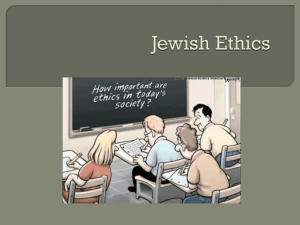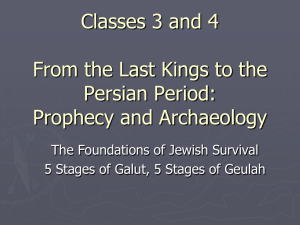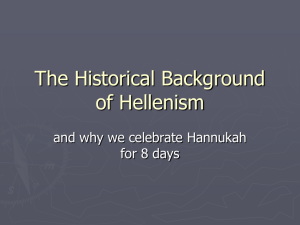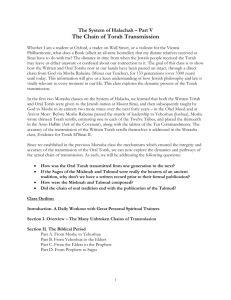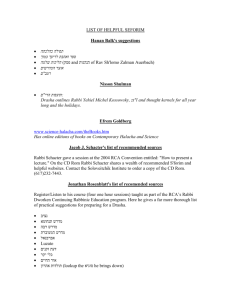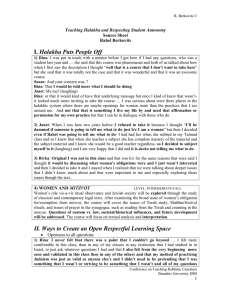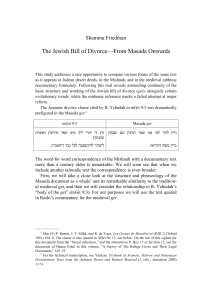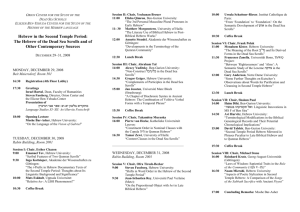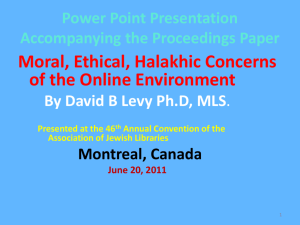Slides - Rabbinics
advertisement
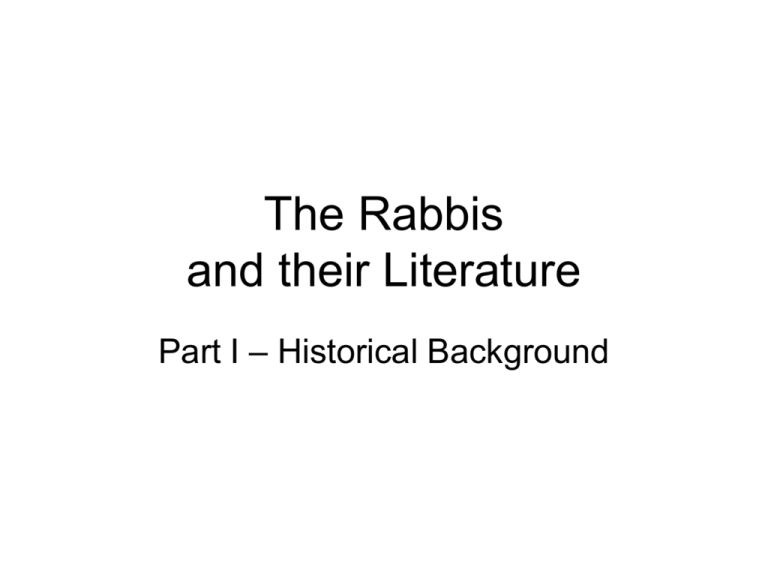
The Rabbis and their Literature Part I – Historical Background King David - 1000BCE Destruction of Temple I 586 BCE by Nebuchadnezzar Cyrus the Great conquers the Babylonians and permits the Jews to return to Israel and rebuilt the Temple 539BCE Building of Temple II 516 BCE under Zerubabel Purim Story – under Persians Alexander the Great http://www.youtube.com/watch?v=MQfBinQwPGs&feature=email Hanukah Story – 164 BCE Destruction of Temple II – 70 CE Arch of Titus Rabbis Reconvene at Yavneh after 70 CE Bar Kokhba Revolt - 132 CE Front: Trumpets. ""לחרות ירושלים Back: Lyre. ""ש[נה] ב לחר[ות] ישראל Texts and Time Periods 1000BCE 586 BCE 539 BCE 516 BCE 332 BCE 164 BCE 150BCE-70CE 70 CE 132 CE 50-200 CE 220 CE 200-500 CE 400 CE 500-700 CE 600 CE King David Destruction of Temple I Cyrus the Great – Persian rule Second Temple Built Alexander the Great – Greek rule Maccabean Revolt Pharisees Second Temple Destroyed Bar Kokhba Revolt Tannaitic Period Mishnah & Tannaitic Midrash Compiled Amoraic Period Yerushalmi & Amoraic Midrash Compiled Savoraim in Babylonia Bavli Completed Rabbinic Texts Tannaitic Midrashim Amoraic Midrashim Mishnah Tosefta Talmud Yerushalmi 200CE 400CE Talmud Bavli 600CE See https://fc.gannacademy.org/gannopedia/genremap/rlgenremaphebrew.html Generations of Tannaim 1 Rabban Yohanan ben Zakkai's generation 40-80CE 2 Rabban Gamliel of Yavneh, Rabbi Eliezer and Rabbi Yehoshua's generation, the teachers of 80-110 Rabbi Akiva. 3 The generation of Rabbi Akiva and his 110-135 colleagues, R. Ishmael. 4 The generation of Rabbi Meir, Rabbi Yehuda 135-170 and their colleagues. Live in Usha. 5 Rabbi Judah haNasi's generation 170-200 Tannaitic Midrash רבי ישמעאל רבי עקיבא ------ ------ בראשית שמות מכילתא דרבי ישמעאל (רק קטעים) מכילתא דרבי שמעון בר יוחאי ספרא במדבר ספרי ספרי זוטא דברים מדרש תנאים ספרי ויקרא Why is it called the “Mishnah”? The Hebrew root "ShNH" means "to repeat," ( )ושננתם לבניךand refers to memorization by repetition. "Mishnah" therefore has the sense of "that which is memorized by rote," as distinct from the Rabbinic designation for the Bible: "Miqra,"that which is read and recited from a written text. The Jewish sages whose statements are quoted in the Mishnah are known as Tanna'im (singular: "Tanna"), derived from the Aramaic root related to the Hebrew "ShNH". The era in which the Mishnah was developed is therefore referred to as the "Tanna'itic" era. “Our” Mishnah On the Talmud page, the passages from the Mishnah (for which the Talmud serves as a commentary) are introduced with the abbreviation "MTNY'," short for the Aramaic “Matnitin," "our mishnah." It is customary for the Babylonian Talmud to refer to "our Mishnah" (or: We learned), to distinguish it from other, "external," mishnahs, referred to in Aramaic as "baraita.“ Some of the bataitot are collected in the Tosefta. Contents of the Mishnah First Order: Zeraim ("Seeds"). 11 tractates. It deals with agricultural laws and prayers. Second Order: Moed ("Festival"). 12 tractates. This pertains to the laws of the Sabbath and the Festivals. Third Order: Nashim ("Women"). 7 tractates. Concerns marriage and divorce. Fourth Order: Nezikin ("Damages"). 10 tractates. Deals with civil and criminal law. Fifth Order: Kodshim ("Holy things"). 11 tractates. This involves sacrificial rites, the Temple, and the dietary laws. Sixth order: Tohorot ("Purities"). 12 tractates. This pertains to the laws of purity and impurity, including the impurity of the dead, the laws of ritual purity for the priests (cohanim), the laws of "family purity" (the menstrual laws) and others. Order of Masechtot within a Seder Rambam tries to explain order of tractates in the Mishnah based on either chronological or logical progression. SEDER MOED Shabbat Eruvin Pesachim Shekalim Yoma Sukkah Beitzah Rosh Hashanah Ta'anint Megillah Moed Katan Hagigah SEDER MOED Shabbat 24 Eruvin 10 Pesachim 10 Shekalim 8 Yoma 8 Sukkah 5 Beitzah 5 Rosh Hashanah 4 Ta'anint 4 Megillah 4 Moed Katan 3 Hagigah 3 SEDER NASHIM Yevamot 16 Ketubot 13 Nedarim 11 Nazir 9 Sotah 9 Gittin 9 Kiddushin 4 SEDER NEZIKIN Bava Kamma Bava Metzia Bava Batra Sanhedrin Makkot Shevuot Edutoyot Avodah Zarah Avot Horayot 10 10 10 11 3 8 8 5 5 (6) 3 SEDER KODASHIM Zevahim Menahot Hullin Bekhorot Arakhin Terumah Keritot Me'ilah Tamid Middot Kinnim 14 13 12 9 9 7 6 6 6 5 3 SEDER TOHOROT Keilim Oholot Negaim Parah Tohorot Mikvaot Niddah Makshirin Zavim Tevul Yom Yadaim Uktzin 30 18 14 12 10 10 10 6 5 4 4 3 SEDER ZERAIM Berakhot Peah Demai Kilaim Sheviit Terumot Ma'asrot Ma'aser Sheini Hallah Orlah Bikkurim 9 8 7 9 10 11 5 5 4 3 4 The most reliable complete manuscript of the Mishnah. …Save one life משנה מסכת סנהדרין פרק ד משנה ה לפיכך נברא אדם יחידי ללמדך שכל המאבד נפש אחד מישראל מעלה עליו הכתוב כאילו איבד עולם מלא וכל המקיים נפש אחת מישראל מעלה עליו הכתוב כאילו קיים עולם מלא ומפני שלום הבריות שלא יאמר אדם לחבירו אבא גדול מאביך http://www.youtube.com/watch?v=uvGu3Y9e8y0 Mishnah Sanhedrin 4:5 – Ms. Kaufman Comparing Mishnah & Tosefta תוספתא מסכת חולין פרק ח הלכה ו טיפת חלב שנפלה על החתיכה ר' יהודה אומר אם יש בנותן טעם באותה חתיכה וחכמים אומרים באותה הקדרה אמר רבי נראין דברי ר' יהודה בזמן שלא ניער ולא כסה ודברי חכמים בזמן שניער וכסה: משנה מסכת חולין פרק ח טיפת חלב שנפלה על החתיכה אם יש בה בנותן טעם באותה חתיכה אסור ניער את הקדרה אם יש בה בנותן טעם באותה קדרה אסור Purpose of Mishnah Book of Practical Halakha Quotes the opinion of a single Rabbi in the Tosefta as “the Sages” in order to say that he represent the Halakha. Textbook of Oral Tradition There are still multiple opinion and contradictions within the Mishnah. Also, Mishnah includes impractical temple and purity laws. Why Include Controversy? Eduyot ch. 1, Mishnah 5. And why do they record the opinion of a single person among the many, when the Halachah must be according to the opinion of the many? So that if a court prefers the opinion of the single person it may depend on him. For no court may set aside the decision of another court unless it is greater than it in wisdom and in number. If it was greater than it in wisdom but not in number, in number but not in wisdom, it may not set aside its decision, unless it is greater than it in wisdom and in number. Mishnah 6. R. Judah said: if so, why do they record the opinion of a single person among the many to set it aside? So that if a man shall say, thus have I learnt the tradition,’ it may be said to him, ‘according to the [refuted] opinion of that individual did you hear it. Historical context of the Mishnah 451BCE – 12 Tablets 131CE – Hadrian issued the “Perpetual Edict” which froze and codified the praetorian edicts 2nd-3rd centuries, legal jurists (like Gaius, Paulus, Ulpian, and Papinian) write law commentaries and codes 438 – Theodosian Code 530 – Justinian Code Deciding Dispute Codex Theodosianus, 1.4.3.2-4: Law of Citations (426CE): When conflicting opinions are cited, the greater number of the authors shall prevail, or if the numbers should be equal, the authority of that group shall take precedence in which the man of superior genius, Papinian, shall tower above the rest, and as he defeats a single opponent, so he yields to two…Furthermore, when their opinions as cited are equally divided and their authority is rated as equal, the regulation of the judge shall choose whose opinion he shall follow. Yerushalmi Terumah 3:1 (42a) R. H iyya said in the name of R. Yoh anan, ‘[In a dispute between] Rabbi and his colleagues, the halakha follows Rabbi.’ And R. Yonah said, ‘Even between Rabbi and R. Eleazar b. R. Shimon’… R. Yose said in the name of R. Yoh anan, ‘In a dispute between R. Yose and his colleagues, the halakha accords with R. Yose.’ R. Zeira and R. Yaakov bar Idi [said] in the name of R. Yoh anan, “In a dispute between R. Meir and R. Shimon, the halakha follows R. Shimon. [In a dispute between] R. Shimon and R. Yehudah, the halakha follows R. Yehudah. It thus goes without saying [that in a dispute between] R. Meir and R. Yehudah, the halakha follows R. Yehudah.” Amoraim 1 220-260 2 260-290 3 290-320 4 320-350 5 350-400 6 400-500 Eres Yisrael Bavel Yehoshua ben Levi Rav (Sura) Shmuel (Nehardea) Rav Yehuda Rav Huna Rabbah Rav Nahman Abaye and Rava R. Yohanan R. Zeira R. Yirmiah R. Yehuda Hanasi IV Rav Papa Rav Ashi Important Political Events 313CE Constantine converted to and declared toleration for Christianity 351CE Jewish Revolt against Gallus protesting anti-Jewish legislation 362CE Julian the Apostate announced rebuilding of the Bet Hamikdash 380 Christianity declared the official religion of the roman empire 395 Roman Empire splits into two 425CE Elimination of the Patriarchate 638CE Muslim Conquest Texts and Time Periods 1000BCE 586 BCE 539 BCE 516 BCE 332 BCE 164 BCE 150BCE-70CE 70 CE 132 CE 50-200 CE 220 CE 200-500 CE 400 CE 500-700 CE 600 CE King David Destruction of Temple I Cyrus the Great – Persian rule Second Temple Built Alexander the Great – Greek rule Maccabean Revolt Pharisees Second Temple Destroyed Bar Kokhba Revolt Tannaitic Period Mishnah & Tannaitic Midrash Compiled Amoraic Period Yerushalmi & Amoraic Midrash Compiled Savoraim in Babylonia Bavli Completed The Rabbis and their Literature Part II – Methodology Charles James Ball We have to bear in mind a fact familiar enough to students of the Talmudic and Midrashic literature, though apparently unknown to many expositors of Scripture, whose minds conspicuously lack that orientation which is an indispensable preliminary to a right understanding of the treasures of Eastern thought; I mean, the inveterate tendency of Jewish teachers to convey their doctrine not in the form of abstract discourse, but in a mode appealing directly to the imagination, and seeking to rouse the interest and sympathy of the man rather than the philosopher. The Rabbi embodies his lesson in a story, whether parable or allegory or seeming historical narrative; and the last thing he or his disciples would think of is to ask whether the selected persons, events, and circumstances which so vividly suggest the doctrine are in themselves real or fictitious. The doctrine is everything; the mode of presentation has no independent value. To make the story the first consideration, and the doctrine it was intended to convey an afterthought, as we, with our dry Western literalness, are predisposed to do, is to reverse the Jewish order of thinking, and to do unconscious injustice to the authors of many edifying narratives of antiquity.
